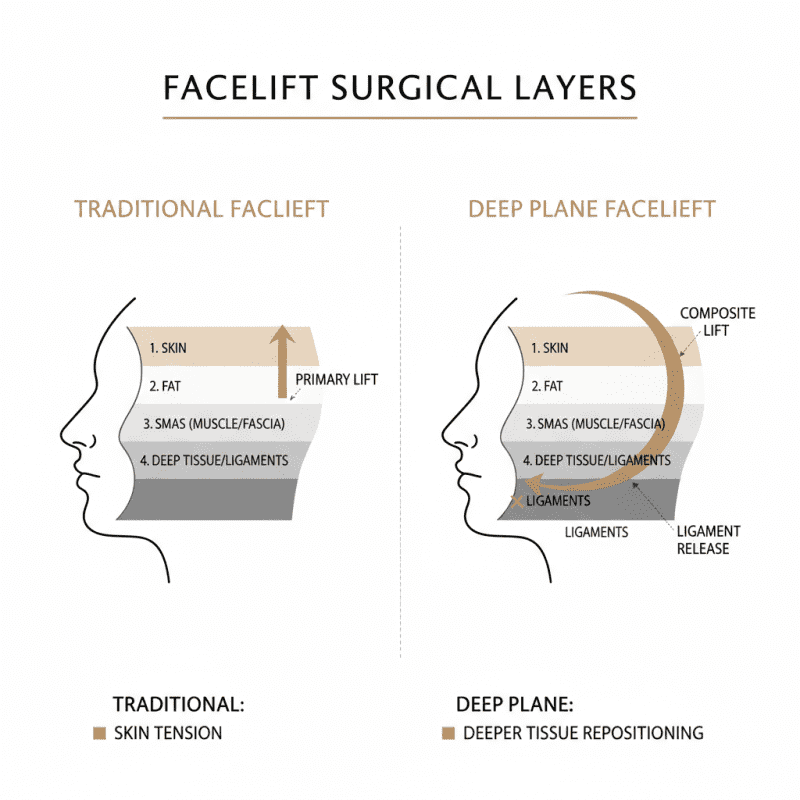What to Expect: Deep Plane Facelift Recovery Unveiled

Understanding the Deep Plane Facelift
Considering a deep plane facelift is an important journey toward a refreshed look. We understand you want natural, lasting results. Knowing what to expect during recovery is key to a smooth experience. It helps us prepare well.
Our guide will explain the deep plane facelift recovery time. We will cover the full timeline, from the first few days to the final outcome. You will learn how to manage discomfort, reduce swelling, and speed up your healing. We are here to give you clear, helpful information. This way, you can approach your recovery with confidence.

A deep plane facelift is a sophisticated surgical procedure designed to address the more advanced signs of facial aging. Unlike traditional facelifts that primarily tighten the skin, the deep plane technique targets the underlying muscular and connective tissue layers of the face, specifically the Superficial Musculoaponeurotic System (SMAS) and the retaining ligaments. By repositioning these deeper structures, we can achieve more comprehensive, natural-looking, and longer-lasting rejuvenation. This method effectively lifts sagging cheeks, smooths deep nasolabial folds (lines from the nose to the mouth), and redefines the jawline and neck contours, avoiding the pulled or “mask-like” appearance sometimes associated with older facelift techniques.
What Makes a Deep Plane Facelift Different?
The fundamental difference of a deep plane facelift lies in its approach to facial anatomy. Instead of merely separating the skin from the underlying tissues and pulling it taut, the deep plane technique involves releasing specific retaining ligaments and lifting the skin, fat, and muscle (SMAS) as a single, composite unit. This integrated lift allows for a more significant and natural repositioning of the facial structures, addressing the root causes of sagging.
This method offers several key advantages:
- Deeper Tissue Repositioning: By working beneath the SMAS layer, we can effectively lift sagging tissues in the mid-face, jawline, and neck, providing a more youthful contour.
- Releasing Retaining Ligaments: These ligaments, which anchor the facial tissues to the bone, are released to allow for tension-free repositioning. This is crucial for achieving a smooth, natural result without excessive pulling on the skin.
- Lifting Skin and Muscle as One Unit: This unified lift minimizes tension on the skin, which can lead to less visible scarring and a more natural appearance. It also maintains a better blood supply to the skin, potentially aiding in a smoother recovery.
- Addressing Mid-Face and Neck: The deep plane technique is particularly effective in rejuvenating the mid-face, which often experiences significant volume loss and descent, and in providing a more defined and sculpted neck and jawline.

Are You a Good Candidate?
While the deep plane facelift offers remarkable results, it’s not suitable for everyone. Ideal candidates typically exhibit:
- Significant Jowling: Pronounced sagging along the jawline that obscures a youthful contour.
- Deep Nasolabial Folds: Prominent lines extending from the sides of the nose to the corners of the mouth.
- Sagging Neck Skin: Loose skin and banding in the neck area that contributes to an aged appearance.
- Good Overall Health: Candidates should be in good physical health, free from medical conditions that could impair healing.
- Realistic Expectations: Understanding the potential outcomes and the recovery process is crucial for patient satisfaction.
- Non-Smoker: Smoking significantly impairs healing and increases complication risks, making it a critical factor for candidacy. We typically require patients to cease smoking several weeks before and after surgery.
The Comprehensive Timeline for Deep Plane Facelift Recovery

The recovery journey after a deep plane facelift is often described as a year-long process with distinct milestones. While the most intense part of the healing occurs in the first few weeks, subtle changes and improvements continue for many months. Managing expectations and understanding this timeline is essential for a smooth and positive experience. We guide our patients through each physical and emotional stage, emphasizing that gradual improvement is the norm.
The First 72 Hours: Rest and Management
The initial 72 hours post-surgery are crucial for laying the groundwork for a successful recovery. You can expect to experience:
- Initial Discomfort: Pain levels can initially be up to seven out of ten, but typically decrease substantially over the first 2-4 days. We will prescribe appropriate pain medication to manage any discomfort.
- Head Elevation: Keeping your head liftd, even while sleeping, is vital to minimize swelling. We recommend using several pillows or a recliner.
- Cold Compresses: Applying cold compresses to the treated areas intermittently for the first 48-72 hours helps reduce swelling and bruising.
- Significant Swelling and Bruising: This is the most dramatic phase of recovery. Your face will appear swollen and bruised, and the bruising might actually look worse before it looks better. This is completely normal.
- Drains and Bandages: You will likely have surgical drains in place to prevent fluid buildup and a compression bandage to support the healing tissues and reduce swelling. These are usually removed within the first few days.
- Limited Activity: Rest is paramount. We advise minimal activity during this period, focusing solely on your recovery.
Week 1: Turning the Corner
As you move past the initial 72 hours, you’ll start to notice subtle shifts:
- Peak Swelling: Swelling and bruising generally peak a few days following surgery, typically around days 2-4, before gradually starting to subside.
- Bruising Changes Color: The bruising will begin to change color, often from deep purple to green and yellow, indicating the healing process is underway.
- Suture Removal: Stitches are typically removed between days seven and ten.
- Feeling of Tightness: You will continue to feel tightness and numbness in the treated areas as the tissues settle.
- “Unpresentable” Phase: During this first week, most patients are still considered “unpresentable” due to the visible signs of surgery. It’s a time for quiet recuperation at home.
- Feeling Better but Bored: While you’ll likely feel physically better, the restricted activity can lead to feelings of boredom. Gentle walking around the house is usually encouraged to promote circulation.
Weeks 2-4: Returning to Social Life
This period marks a significant turning point in your recovery, as visible signs of surgery diminish:
- “Restaurant Ready”: By the two-week mark, many patients feel comfortable enough to go out in public, often described as “restaurant ready,” with residual bruising and swelling that can be concealed with makeup.
- Significant Reduction in Swelling and Bruising: Between day 10 and day 20, some of the most noticeable early changes occur, with a marked reduction in swelling and bruising.
- Return to Sedentary Work: People who work in sedentary jobs, such as in an office, can usually return to work after a week or two. Most patients are ready to return to social activities by the 3-week mark (Day 21), with 90% able to do so discreetly.
- Using Makeup to Conceal Bruising: Light makeup can be used to cover any lingering discoloration, allowing for a more confident return to social settings.
- Resuming Light, Non-Strenuous Activities: After a couple of weeks, you can usually resume many of your regular activities, including light, non-strenuous exercise like walking. However, strenuous activities should still be avoided.
Months 1-3: Seeing Major Progress
The first three months bring substantial progress in both appearance and sensation:
- 80% of Swelling Resolved: By one month post-surgery, approximately 80% of the initial swelling has typically resolved for the majority of patients. While you might still feel your face looks ‘pillowy’ or has residual puffiness, especially in the mornings, it’s a significant improvement.
- Numbness and Tightness Begin to Subside: You should regain normal sensations within 6-8 weeks. Lingering numbness in patches or ‘pins and needles’ is normal as sensation returns, indicating nerve healing.
- Resuming Most Exercise (4-6 weeks): While you might feel almost completely back to normal two weeks after your deep plane facelift, it’s usually best to postpone heavy lifting and other forms of strenuous exercise until at least a few weeks or a month after your facelift, typically around 4-6 weeks, after clearance from your surgeon.
- Facial Contours Become More Defined: As swelling continues to dissipate, the newly sculpted facial contours, including a more defined jawline and neck, become increasingly apparent.
- Ready for Major Events: By three months after surgery, the swelling and puffiness have gone down enough that patient results are at the point where they are ready to be the center of attention.
Months 6-12: The Final Results

The journey culminates in the showing of your final, refined results:
- Near-Final Results Visible: Six months after deep plane facelift surgery, patients are almost to their final results from the facelift and are essentially looking their best. Nearly all swelling is gone.
- Sensation Fully Restored: Sensation is typically fully restored by this point, though some minor areas might take longer.
- Scars Mature and Fade: Incision lines, which are strategically placed to be inconspicuous, will continue to mature and fade, becoming virtually unnoticeable. Scars will continue fading for a year after surgery.
- Microscopic Healing Complete: By twelve months, the visible and microscopic signs of recovery are essentially complete, and you can fully appreciate the long-term benefits of your deep plane facelift.
Optimizing Your Healing for a Smoother Recovery
While the body inherently heals itself, there are many proactive steps we can take to optimize your recovery process, potentially speeding up healing and improving the overall outcome. Preparation is key, and understanding the impact of your lifestyle and diligent post-operative care can significantly aid the healing process.
Pre-Surgical Preparation
The success of your recovery begins even before surgery. Thorough pre-surgical preparation is paramount:
- Arranging for Help at Home: Ensure you have a trusted friend or family member to assist you during the initial days, especially for driving, meal preparation, and general support.
- Stopping Smoking and Alcohol: Both nicotine and alcohol can severely impede the healing process by constricting blood vessels and affecting circulation. We require patients to stop smoking at least six weeks prior to surgery and abstain from alcohol for a specified period.
- Avoiding Blood-Thinning Medications: Certain medications and supplements, such as aspirin, ibuprofen, and some herbal remedies (e.g., Vitamin E, ginkgo biloba, fish oil, Arnica Montana), can increase bleeding and bruising. We will provide a comprehensive list of what to avoid for at least two weeks before surgery.
- Preparing a Recovery Space: Set up a comfortable, clean, and easily accessible recovery area at home. Stock it with essentials like soft foods, plenty of water, entertainment, and any prescribed medications.
- Filling Prescriptions: Have all prescribed medications, including pain relievers and antibiotics, filled before your surgery date to avoid last-minute stress.
The Role of Diet and Lifestyle in Healing
Your body needs proper fuel to repair and regenerate tissues effectively:
- Low-Sodium Diet: Reducing sodium intake helps minimize fluid retention and swelling.
- High-Protein Foods: Protein is the building block for new tissues. Incorporate lean meats, fish, eggs, and plant-based proteins to support wound healing.
- Staying Hydrated: Drinking plenty of water is crucial for overall health and helps flush toxins, aiding in the reduction of swelling.
- Avoiding Alcohol: Continue to avoid alcohol during recovery as it can dehydrate you and interact negatively with medications.
- Gentle Movement: Light walking, as approved by us, promotes healthy circulation, which is vital for delivering oxygen and nutrients to healing tissues and reducing the risk of blood clots.
- Importance of Rest: Adequate sleep allows your body to dedicate energy to healing. Resist the urge to overexert yourself, even if you feel better.
Essential Post-Operative Care for Your Deep Plane Facelift Recovery
Diligent adherence to post-operative instructions is non-negotiable for optimal results:
- Incision Care: We will provide specific instructions on how to gently clean and care for your incision sites to prevent infection and promote proper healing. This often involves distilled water and a thin layer of ointment like Aquaphor.
- Sun Protection: Protecting your healing skin from the sun is crucial. Use a broad-spectrum sunscreen with SPF 50+ and wear wide-brimmed hats when outdoors. Sun exposure can darken scars and impede healing.
- Sleeping Position: Continue to sleep with your head lifted above your chest for at least one week, and on your back for several weeks, to minimize swelling and protect the surgical sites.
- The importance of choosing an experienced surgeon cannot be overstated, as their technique and post-operative care plan significantly influence the healing process. A board-certified surgeon specializing in facial procedures will have a refined protocol, as seen in the approach to a Dr. Soler-Baillo deep plane recovery.
Long-Term Results and Maintenance
One of the most compelling aspects of a deep plane facelift is the longevity of its results. While the surgery effectively turns back the clock, natural aging continues. However, with proper maintenance, you can enjoy a significantly more youthful appearance for many years, always looking younger than if you hadn’t had the procedure.
How Long Do Deep Plane Facelift Results Last?
The results of a deep plane facelift are renowned for their durability. Most patients can enjoy their refreshed faces and necks for 10 to 15 years or even longer. This extended longevity is a key advantage of the deep plane technique, as it addresses the deeper structural causes of aging rather than just the superficial skin. Factors influencing how long your results last include genetics, lifestyle choices, and diligent skincare.
How to Maintain Your Results
To maximize the longevity and quality of your deep plane facelift results, we recommend a proactive approach to maintenance:
- Consistent Medical-Grade Skincare: Invest in a high-quality, medical-grade skincare regimen custom to your skin type. Products with retinoids, antioxidants, and growth factors can help maintain skin health and elasticity.
- Daily Sun Protection: Daily use of broad-spectrum sunscreen (SPF 30 or higher) is non-negotiable. Sun exposure is a primary cause of premature aging and can compromise the quality of your skin over time.
- Maintaining a Stable Weight: Significant fluctuations in weight can stretch the skin and facial tissues, potentially impacting the long-term results of your facelift.
- Healthy Diet and Lifestyle: A balanced diet rich in fruits, vegetables, and lean proteins, coupled with regular exercise and adequate sleep, contributes to overall skin health and can help preserve your youthful appearance.
- Non-Invasive Treatments: Complementary non-surgical treatments like Botox, dermal fillers, laser resurfacing, and microneedling can help address new signs of aging as they emerge, further extending and enhancing your facelift results. These treatments can target fine lines, volume loss, and skin texture without the need for additional surgery.
Frequently Asked Questions about Deep Plane Facelift Recovery
What are the potential complications during deep plane facelift recovery, and how are they managed?
While deep plane facelifts are generally safe, like any surgical procedure, there are potential complications during recovery. These can include:
- Hematoma (blood collection): This is the most common complication and typically involves a collection of blood under the skin. It’s usually managed by returning to the operating room to drain the blood.
- Infection: Though rare, infection can occur. It’s managed with antibiotics and, in some cases, drainage. Following our strict incision care instructions is crucial for prevention.
- Nerve Injury: Temporary numbness or weakness in facial muscles is possible due to nerve manipulation. Permanent nerve damage is very rare, especially with an experienced surgeon, but can occur. Most temporary issues resolve within weeks to months.
- Poor Scarring: While incisions are placed strategically to be inconspicuous, individual healing varies. Factors like genetics, sun exposure, and smoking can affect scar quality. Scar management techniques like silicone sheets or massage can help. It’s vital to follow all post-operative instructions diligently and contact us immediately if you experience excessive pain, fever, unusual swelling, or any other concerning symptoms.
How does recovery compare to a mini-facelift?
The recovery time and overall experience can differ significantly between a deep plane facelift and a mini-facelift, primarily due to the extent of the surgical intervention.
Feature Deep Plane Facelift Mini-Facelift Invasiveness More invasive, addresses deeper tissues (SMAS, ligaments) Less invasive, targets superficial tissues and limited areas Target Areas Mid-face, jawline, neck, deep folds Jawline, mild jowling, upper neck Recovery Time Initial recovery 2-4 weeks; full healing 6-12 months Initial recovery 1-2 weeks; full healing 3-6 months Longevity 10-15 years or longer 5-7 years Ideal Candidate Moderate to advanced signs of aging, significant jowling, neck laxity Mild to moderate signs of aging, early jowling, good skin elasticity A mini-facelift typically offers a quicker return to normal activities, often in as little as one to two weeks, because it involves smaller incisions and less extensive tissue manipulation. However, its results are not as dramatic or long-lasting as those achieved with a deep plane facelift. The choice between the two depends on your specific concerns, the degree of aging, and your desired outcome.
Will I have noticeable scars after the surgery?
One of the primary concerns for patients considering a facelift is scarring. We carefully plan incision placement to ensure they are as inconspicuous as possible. For a deep plane facelift, incisions are typically concealed within the hairline, around the natural curves of the ears, and sometimes under the chin.
Here’s what to expect regarding scars:
- Incision Placement: The goal is to hide incisions in natural creases and hair-bearing areas, making them very difficult to detect once healed.
- Scar Maturation Process: Initially, scars will be pink or reddish and slightly raised. Over several months to a year, they will gradually soften, flatten, and fade to a thin, white line that blends with your skin.
- Scar Care Tips: We will provide specific instructions for scar care, which may include gentle massage, silicone sheets or gels, and avoiding direct sun exposure. These measures can significantly improve scar appearance.
- Sun Exposure Avoidance: Protecting scars from the sun is critical during the first year of healing, as UV radiation can cause them to darken and become more noticeable.
- Final Appearance: By twelve months post-surgery, your scars should be fully matured and virtually unnoticeable to the casual observer.
Deep Plane Facelift Recovery
Starting on a deep plane facelift journey is a significant decision, and understanding the recovery process is paramount. We emphasize that recovery is a journey, not a race. Patience is essential, as the full, refined results unfold gradually over many months. Thorough preparation, meticulous adherence to our post-operative instructions, and a healthy lifestyle are your best allies for a smoother experience.
The investment in a deep plane facelift offers long-lasting, natural-looking rejuvenation that can significantly improve your confidence and quality of life. By choosing a skilled, board-certified surgeon and committing to your recovery plan, you can look forward to enjoying a refreshed and revitalized appearance for years to come.
